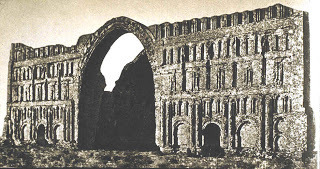Ctesiphon – Fallen city of the Sassanid Kings – Part Two
Beside the River Tigris stand the remains of the royal capital of the great rulers of the Sassanid Persian Empire. The remains of the city of Ctesiphon today lie some 20 miles from Baghdad and have seen better days. The sole surviving monument is the Palace of Khusrow known today in Arabic as the Taq-e Kisra. Only one half of the façade along with the vault of the great iwan now stand. This vaulted mud brick chamber 37 metres high and 26 metres across was at the time of its construction the largest such structure attempted. The chamber was open at the front of the building to create a dramatic archway leading into the royal audience chamber.

The palace was constructed in the reign of Khusrow I (531-579 AD) This mighty king was a contemporary of the Byzantine Emperor Justinian I and fought a series of wars against Byzantium which saw the two superpowers of their day clashing directly or by proxy in conflicts from the Yemen to Georgia. At the same time Khusrow faced the threat on his north eastern frontiers of the Hepthalites or White Huns against whom he waged a war of annihilation.
Under Khusrow, Ctesiphon became an imperial capital as never before. Khusrow took a firm grip on his sprawling territories, gathering more power unto himself than any of his predecessors at the expense of the great noble families who had ruled their own lands as little kings in their own right. Khusrow’s reforms brought the armies and the tax revenues of the Persian Empire directly under royal control for the first time. In the reign of Khusrow all roads led to Ctesiphon and these too were redeveloped to improve the speed of communications within his empire. In his quieter moments Khusrow found time to enjoy playing the game of chess, recently introduced from India.
Under Persian rule, Ctesiphon had only once been subjected to the sack at the hands of the Romans back in 283 AD when the emperor Carus had led a lightning strike down the Euphrates whilst the Persian king and his elite forces were engaged in fighting a civil war far to the east. Carus died, most probably by assassination before he could advance any further into Persia and the Romans retreated. Under Julian the Apostate the Romans had advanced to the very walls of Ctesiphon before the expedition of that remarkable emperor also met with disaster in 363 AD.
In 627 the city faced its gravest threat yet in the form of the emperor Heraclius, who, having put all the armies of the Great King Khusrow II to flight was advancing upon the city, having turned the tables in a war which had seen Persian forces overrun the eastern provinces of the Byzantine Empire and advance to within sight of Constantinople. In the face of impending defeat Khusrow was overthrown and flung into the terrible prison known as the House of Darkness before being done to death shortly afterwards. Peace was established and Heraclius called off his advance. Both empires were militarily exhausted after years of warfare and left vulnerable to a new and unexpected threat from out of the Arabian deserts.
In 636 the forces of the last Sassanid king Yazdegird III were annihilated at Al Qadisiyyah by the forces of the Caliph Umar and two years later the Arabs stormed across the Tigris to put Ctesiphon to the sack for the last time. The Persian king fled, as Darius had fled from Alexander, leaving his palace to be looted by the Arab conquerors, who would make the land their own. In these early days of the Arab conquests the division of the spoils was scrupulously handled with a fifth going to the Caliph and the remainder being equally shared out amongst the conquerors. According to one Arab account, the most remarkable item taken from the palace of Ctesiphon was a magnificent carpet known as the King’s Spring which depicted a stream flowing through a garden and measured one hundred feet across. Precious jewels were even sewn into the carpet. The carpet was sent to the Caliph who ordered it cut into small pieces and distributed amongst the faithful. One has to wonder how such an unwieldy object could have been transported in one piece however.
Following its conquest by the Arabs, Ctesiphon was abandoned and the new cities of Basra and Kufa grew up around military camps to become the major centres of the province of Iraq. The ruins of Ctesiphon were systematically plundered during the 9th Century for the construction of the city of Baghdad which became the capital of the Abbasid Caliphate and one of the most sophisticated cities of the Middle Ages. The Caliph Al Mansur is said to have considered pulling down Khusrow’s palace but was deterred by the scale of the task. The great iwan was allowed to stand therefore and it still stands today against the ravages of time. In 1888 the Tigris flooded and carried away half of the façade. This photograph shows the remains of the palace before the flood.
 http://www.cais-soas.com/CAIS/Architecture/ayvan_e_khosrow.htmhttp://www.islamic-architecture.info/WA-IQ/WA-IQ-019.htm
http://www.cais-soas.com/CAIS/Architecture/ayvan_e_khosrow.htmhttp://www.islamic-architecture.info/WA-IQ/WA-IQ-019.htmCtesiphon - Fallen City of the Sassanid Kings - Part Onehttp://slingsandarrowsblog.blogspot.co.uk/2012/10/ctesiphon-fallen-city-of-sassanid-kings.html
Published on December 04, 2012 02:48
No comments have been added yet.
Slings and arrows
Nuggets of history from the author of 'The Battles are the Best Bits'.
Nuggets of history from the author of 'The Battles are the Best Bits'.
...more
- Simon B. Jones's profile
- 22 followers



